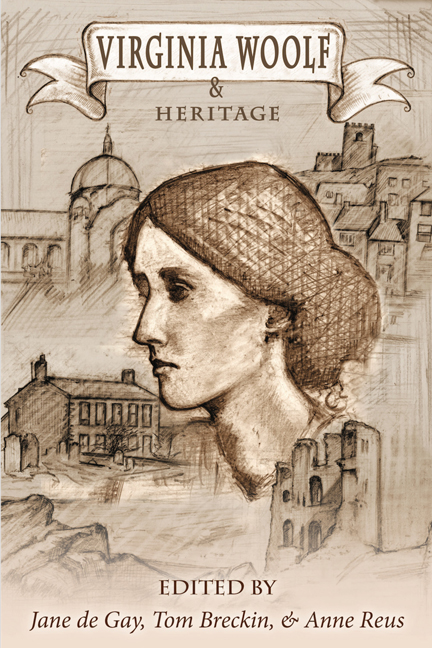Book contents
- Frontmatter
- Contents
- Introduction
- List of Abbreviations
- HERITAGE: A DEBATE
- HERITAGE, EDUCATION, AND MENTORING
- HERITAGE SPACES
- LITERARY AND CULTURAL HERITAGES
- QUEER PASTS
- MODERNISM AND HERITAGE
- Resetting the Type: An Exploration of the Historical Sense in Mrs. Dalloway
- Kenya Colony and the Kenya Novel: The East African Heritage of “A Very Fine Negress” in A Room of One's Own
- Leonard Woolf 's Fear and Politics: A Debate at the Zoo: Satirical Heritage as Apocalyptic Prophecy
- Virginia Woolf and the War on Books: Cultural Heritage and Dis-Heritage in the 1930s
- Gender Roles and the War Machine: An Undergraduate Roundtable on Virginia Woolf 's Legacies
- WRITING LIVES AND HISTORIES
- WOOLF'S LEGACIES
- FINALE
- Notes on Contributors
Resetting the Type: An Exploration of the Historical Sense in Mrs. Dalloway
from MODERNISM AND HERITAGE
- Frontmatter
- Contents
- Introduction
- List of Abbreviations
- HERITAGE: A DEBATE
- HERITAGE, EDUCATION, AND MENTORING
- HERITAGE SPACES
- LITERARY AND CULTURAL HERITAGES
- QUEER PASTS
- MODERNISM AND HERITAGE
- Resetting the Type: An Exploration of the Historical Sense in Mrs. Dalloway
- Kenya Colony and the Kenya Novel: The East African Heritage of “A Very Fine Negress” in A Room of One's Own
- Leonard Woolf 's Fear and Politics: A Debate at the Zoo: Satirical Heritage as Apocalyptic Prophecy
- Virginia Woolf and the War on Books: Cultural Heritage and Dis-Heritage in the 1930s
- Gender Roles and the War Machine: An Undergraduate Roundtable on Virginia Woolf 's Legacies
- WRITING LIVES AND HISTORIES
- WOOLF'S LEGACIES
- FINALE
- Notes on Contributors
Summary
Virginia Woolf 's diaries reveal that she crafted Mrs. Dalloway during a period of her life in which she developed a personal and collaborative relationship with T. S. Eliot and his poetry. After a short period of personal acquaintance, Eliot read The Waste Land to Leonard and Virginia Woolf in June of 1922, only two months before Virginia started Mrs. Dalloway (D2 178; 189). The poem made a strong impression on Virginia, who claimed that though she did not fully understand The Waste Land, it left her with “some strong emotion” (D2 178). Throughout the years she worked on Mrs. Dalloway, Woolf became increasingly involved in Eliot's life and career, investing time in finding him housing, patronage, and even a job (Steinberg 6). Eventually, the Woolfs published The Waste Land at the Hogarth Press; Virginia personally set the type for the poem in 1923 (Steinberg 6). Due to the intimate process of manually setting the type for The Waste Land, it is not surprising that images of the poem found their way into Mrs. Dalloway. However, as this paper will demonstrate, the ways in which Woolf repurposes Eliot's imagery illustrate her desire to reevaluate the implications of his poetry.
To understand the possible motivation behind Woolf 's repurposing, one should consider the critical debates that provided a context for the novel. Around the time Mrs. Dalloway was written, both Woolf and Eliot were writing literary criticism in addition to their creative works. In 1919, Eliot published the essay “Tradition and the Individual Talent” which discusses the ways an author can connect with the literary tradition. As he explains, tradition “cannot be inherited, and if you want it you must obtain it by great labor” (112). Thus, a scholar must work to familiarize herself with the literary tradition in order to develop what Eliot describes as the “historical sense,” or the ability to recognize one's role in history and gain access to the power of tradition. Perhaps Eliot's most important assertion is that no “poet, no artist of any art, has his complete meaning alone” (112). In Eliot's model, meaning is cumulative and cultural. By tapping into the larger historical dialogue embodied by “tradition” meaning is transformed, created anew, challenged, and reproduced. In many ways, it seems that Mrs. Dalloway is a performance of Woolf 's ability to exercise the historical sense.
- Type
- Chapter
- Information
- Virginia Woolf and Heritage , pp. 156 - 161Publisher: Liverpool University PressPrint publication year: 2017



